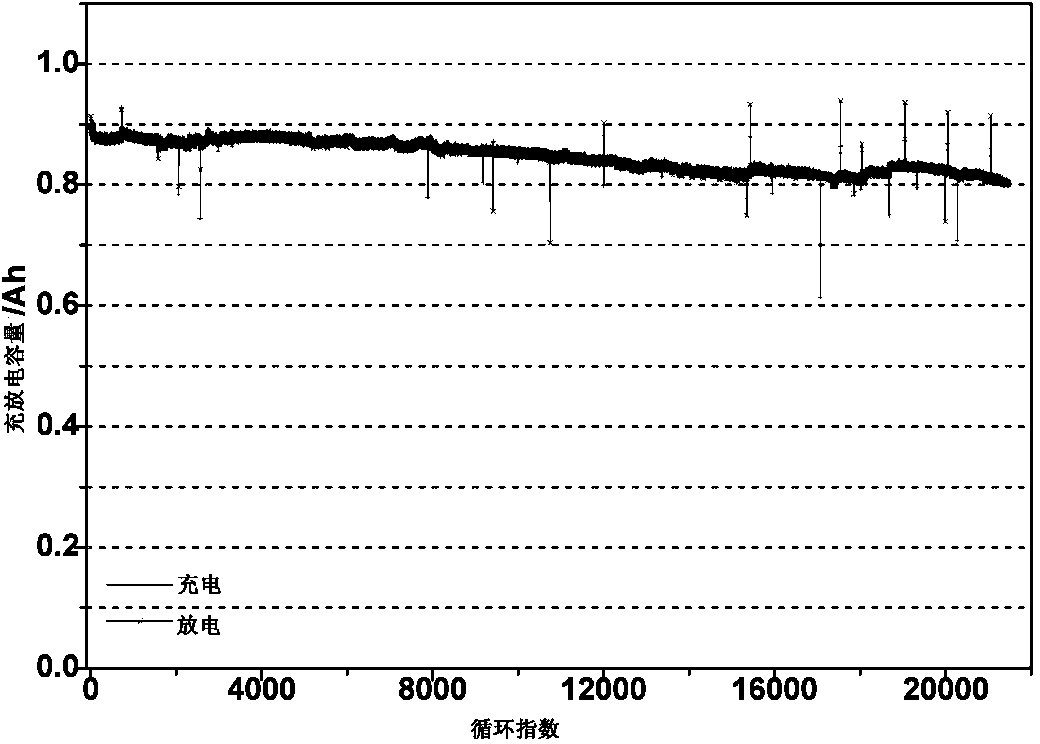Battery paste and lithium ion secondary battery made of battery paste
A secondary battery and lithium ion technology, applied in secondary batteries, battery electrodes, circuits, etc., can solve problems such as description of battery performance impact, description of positive and negative slurry characteristics, etc., to improve consistency and improve contact area effect
- Summary
- Abstract
- Description
- Claims
- Application Information
AI Technical Summary
Problems solved by technology
Method used
Image
Examples
preparation example Construction
[0051] The lithium ion secondary battery prepared by the battery slurry provided by the invention, its preparation method comprises the following steps:
[0052] Step 1, making battery slurry, respectively preparing positive electrode slurry and negative electrode slurry. Specifically include:
[0053] In step 1.1, the proportionally weighed electroactive material, conductive agent and binder are preferably stirred in a stirring container of a planetary mixer for a certain period of time.
[0054] In step 1.2, add a certain amount of N-methylpyrrolidone into the stirring container, control the solid-liquid ratio of the slurry, and stir for a certain period of time.
[0055] In step 1.3, add a certain amount of N-methylpyrrolidone, control the solid-liquid ratio, stir for a certain period of time, and monitor the fineness and viscosity.
[0056] Repeat step 1.3 until the slurry fineness reaches the required value or is close to the particle size of the largest particle in the...
Embodiment 1
[0069] The positive electrode slurry contains 90 parts by mass of spinel lithium manganate, 3 parts by mass of Super-P, 2 parts by mass of KS-6, 5 parts by mass of polyvinylidene fluoride, and the largest primary particle of spinel lithium manganate The particle size is 14.5 microns, the median diameter is 10 microns, the slurry fineness is 18 microns, and the slurry viscosity is 7500mPa·s; the negative electrode slurry contains 85 parts by mass of spinel lithium titanate, 8 parts by mass of Super-P, and 2 parts by mass Parts of superconducting carbon black, 5 parts by mass of polyvinylidene fluoride, the largest primary particle size of spinel lithium titanate is 300 nanometers, the fineness of the slurry is 5 microns, and the viscosity of the slurry is 4200 mPa·s. The positive electrode of the lithium-ion battery is made of positive electrode slurry, and the negative electrode is made of negative electrode slurry.
Embodiment 2
[0071] The positive electrode slurry contains 90 parts by mass of spinel lithium manganate, 3 parts by mass of Super-P, 2 parts by mass of KS-6, 5 parts by mass of polyvinylidene fluoride, and the largest primary particle of spinel lithium manganate The particle size is 14.5 microns, the median diameter is 10 microns, the slurry fineness is 18 microns, and the slurry viscosity is 7500 mPa s; the negative electrode slurry contains 88 parts by mass of spinel lithium titanate, 7 parts by mass of Super-P, and 1 mass part Parts of carbon nanotubes, 4 parts by mass of polyvinylidene fluoride, the largest primary particle size of spinel lithium titanate is 150 nanometers, the fineness of the slurry is 3 microns, and the viscosity of the slurry is 3800 mPa·s. The positive electrode of the lithium-ion battery is made of positive electrode slurry, and the negative electrode is made of negative electrode slurry.
PUM
| Property | Measurement | Unit |
|---|---|---|
| viscosity | aaaaa | aaaaa |
| viscosity | aaaaa | aaaaa |
| particle diameter | aaaaa | aaaaa |
Abstract
Description
Claims
Application Information
 Login to View More
Login to View More - R&D
- Intellectual Property
- Life Sciences
- Materials
- Tech Scout
- Unparalleled Data Quality
- Higher Quality Content
- 60% Fewer Hallucinations
Browse by: Latest US Patents, China's latest patents, Technical Efficacy Thesaurus, Application Domain, Technology Topic, Popular Technical Reports.
© 2025 PatSnap. All rights reserved.Legal|Privacy policy|Modern Slavery Act Transparency Statement|Sitemap|About US| Contact US: help@patsnap.com

